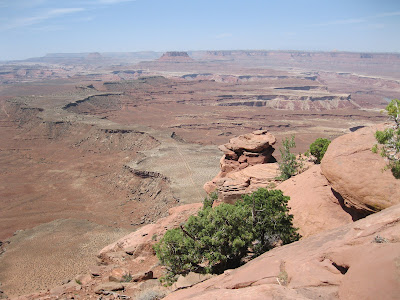The Horseshoe Canyon Trail is a 6.5 mile round trip with 750 feet of elevation change to four rock art sites including the Great Gallery. It is located in a detached Unit of Canyonlands National Park in southeast Utah.
I traveled to Horseshoe Canyon by starting in Green River, Utah and following Utah Route 24 for 24 miles to the east leading gravel road turnoff that is across from the turnoff to Goblin Valley State Park.
It is then 32 miles on the gravel road to the trailhead. The road is drivable with 2-wheel drive but has many washboard sections and occasional sandy spots. After 27 miles there is a left turn at the junction with the road that leads south to the Hans Flat Ranger Station. This junction has some area information posted at a kiosk.
After 3.2 more miles there is an easy to miss right turn onto a one lane dirt road that leads the last 1.8 miles. At the trailhead, there is a pit toilet and an information kiosk. The kiosk information shows a map of the trail. It would be good to take notes on where the rock art sites are in relation to each other because they are not all completely obvious. There isn’t a printed trail guide for this spectacular trail.
The first segment of trail follows a rocky old road that was constructed for oil exploration. There are good views down the canyon that was formerly called Barrier Canyon. The creek seems to still be called Barrier Creek though the canyon has changed names.
A single three toed dinosaur track was outlined with small stones in the upper part of the trail. The last segment of the descent has sandy footing. Much of the canyon bottom has sandy footing also. It took me 0:30 minutes to arrive at the canyon bottom and the trail makes a right turn to the south.
The first rock art site, the High Gallery, arrived in 0:15 minutes more of hiking and was obvious on the left or east wall. The trailhead information says that Barrier Canyon rock art was created by Archaic hunter-gatherers in 1000-2000 BC. Most of the figures are colored red by the mineral hematite.
The canyon bottom is lush is spots with Cottonwood trees and other riparian habitat. There wasn't any flowing water during my hike, but there were wet spots and water is probably just below the surface.
The second rock art site, the Horseshoe Shelter, is within view of the High Gallery but is across the creek on the west side, somewhat concealed by the Cottonwood trees. There is a trail segment on the left side of the creek and it is easy to walk past the second rock art site without seeing the side trail on the right side.
There are two panels to find at the Horseshoe Shelter site. The first is obvious once you are in the vicinity.
There aren't any signs along the trail and no further interpretive information posted beyond what is available at the trailhead. The images at Horseshoe Shelter extend up and to the right.
There is a second panel that is somewhat hidden. There is a marked trail to the right of the main panel that circles around and climbs behind some rocks. This second very short trail is easy to overlook.
From the Horseshoe Shelter, the High Gallery across the creek is clearly visible. I was 1:10 hours into my hike when I was ready to move on. (The hike continues on the next post, or use the Horseshoe Canyon Trail label.)























